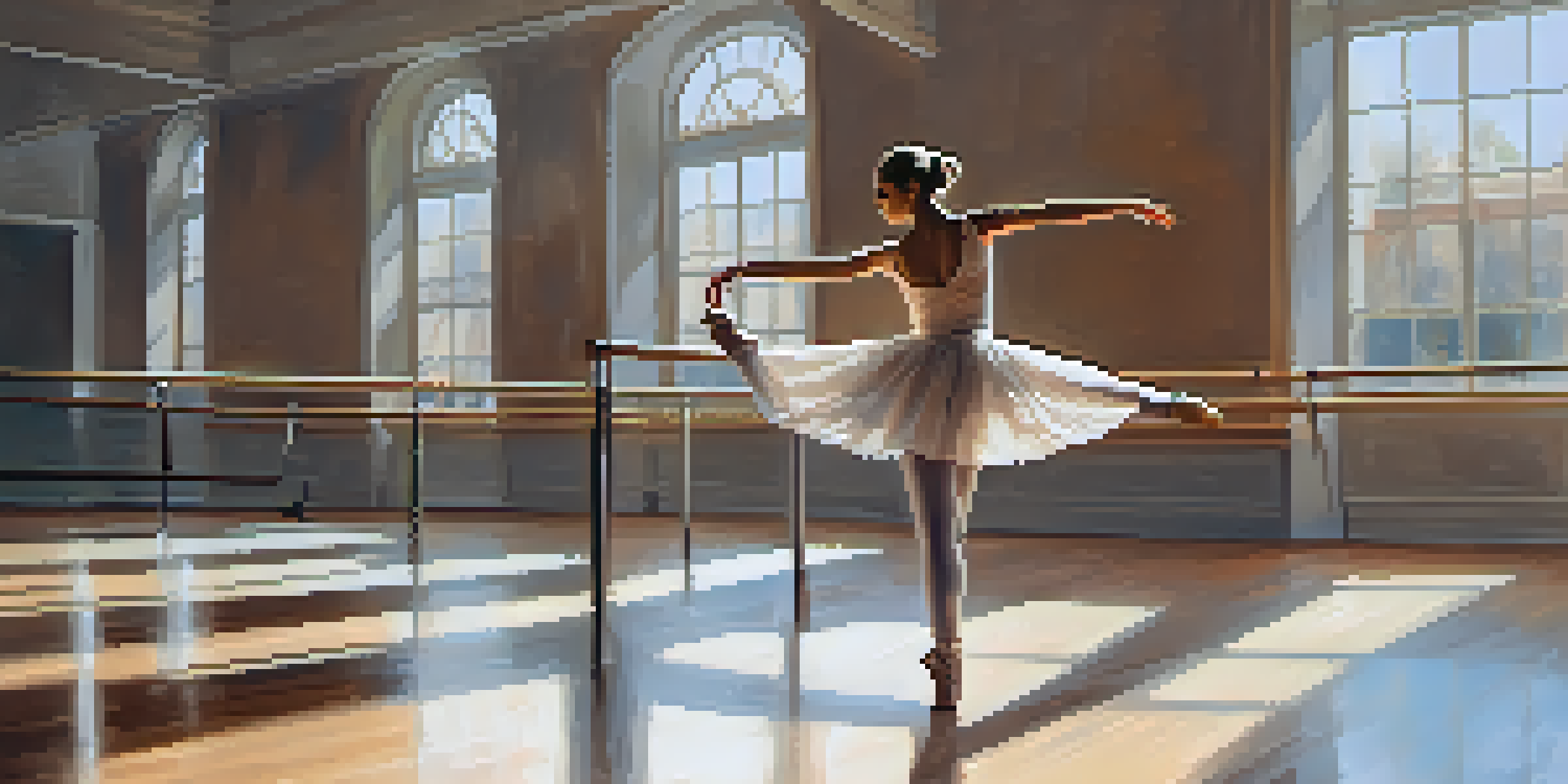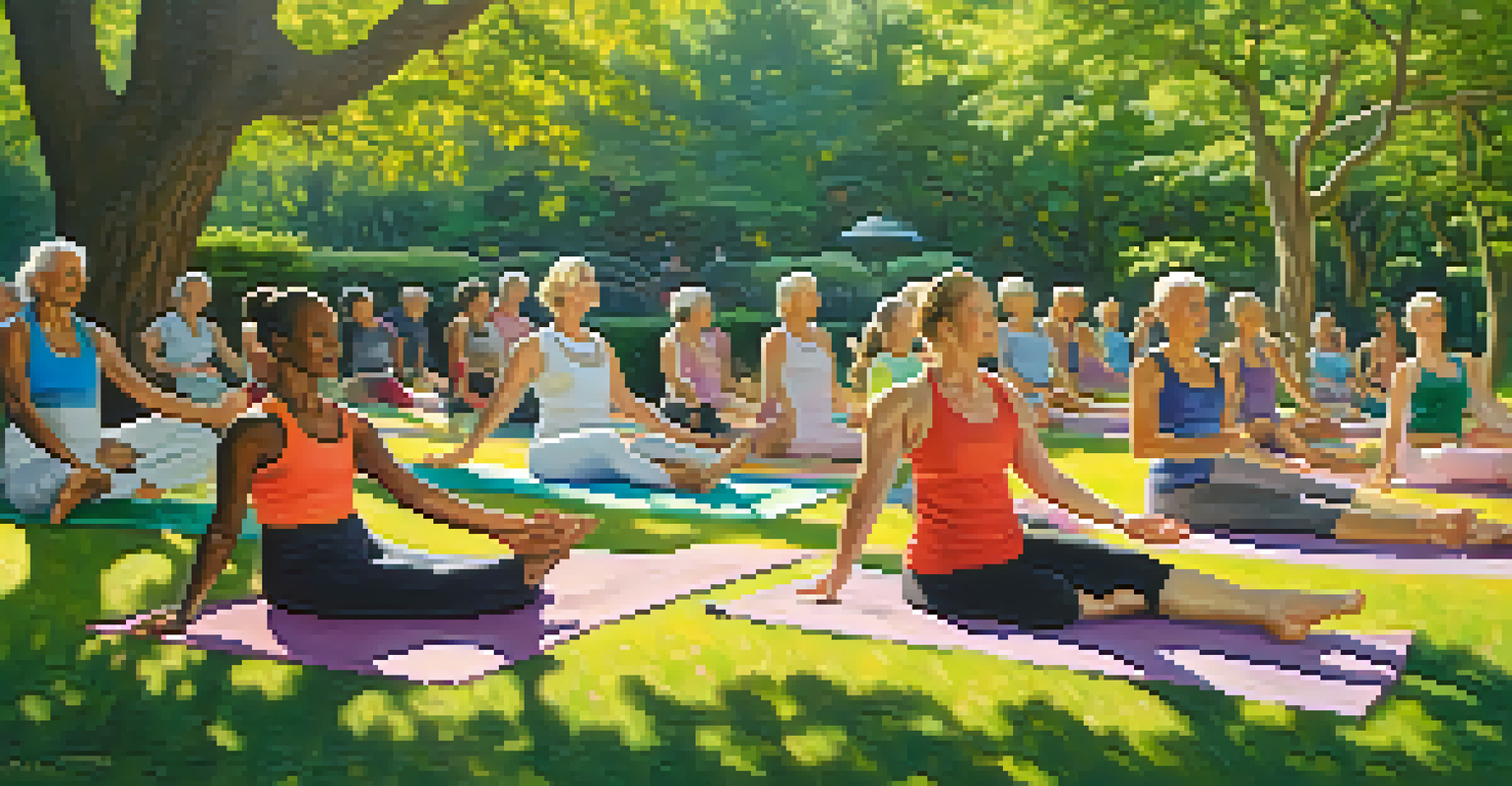Injury Prevention in Dance: Strategies for Older Dancers

Understanding the Unique Challenges Faced by Older Dancers
As dancers age, the body undergoes various changes that can impact performance and increase the risk of injury. Older dancers may experience decreased flexibility, strength, and balance, making it essential to recognize these challenges. For example, a dancer who once executed a perfect grand jeté might find it more difficult as their body ages, highlighting the need for tailored approaches to training.
Dance is the hidden language of the soul.
Additionally, older dancers may have a history of previous injuries that can resurface without proper care and attention. This necessitates a more cautious approach to their dance practice. Understanding these nuances can empower older dancers to adapt their routines and prioritize their health.
Ultimately, acknowledging these unique challenges is the first step towards developing effective injury prevention strategies. By creating a supportive environment that caters specifically to their needs, older dancers can continue to enjoy their passion safely.
The Importance of Proper Warm-Up and Cool-Down Techniques
Warming up before dancing is not just a suggestion; it’s a crucial step in preventing injuries, especially for older dancers. A proper warm-up increases blood flow to the muscles and prepares the body for physical activity. Simple movements like gentle stretches or low-impact exercises can make a significant difference in flexibility and readiness.

Equally important is the cool-down period after dancing. Taking the time to stretch and gradually lower the heart rate can help reduce muscle stiffness and promote recovery. This practice is vital, as it allows the body to transition safely from an active state back to rest, minimizing the risk of injury.
Challenges for Older Dancers
As dancers age, they face unique physical challenges such as reduced flexibility, strength, and an increased risk of injury.
Incorporating these warm-up and cool-down techniques into each dance session not only enhances performance but also sets a strong foundation for long-term health. It’s a small investment of time that pays off in reduced injuries and a longer, more enjoyable dancing career.
Strength Training: Building Resilience for Dancers
Strength training is often overlooked in the dance world, but it plays a vital role in injury prevention, especially for older dancers. By focusing on building muscle strength, dancers can support their joints and improve overall stability. This is particularly important for areas prone to injury, such as the knees and ankles.
A dancer's body is their instrument, and it deserves care and respect.
Incorporating exercises like resistance bands, bodyweight squats, and light weights can enhance muscle tone and endurance. For instance, a dancer who regularly practices these strength exercises may find they can sustain longer and more complex routines without discomfort. This not only boosts confidence but also encourages a more fulfilling dance experience.
Furthermore, strength training should be approached with care. Older dancers should consider working with a trainer familiar with dance-specific needs to ensure exercises are performed safely and effectively. By prioritizing strength, dancers can significantly reduce the likelihood of injuries.
Flexibility Exercises: Key to Injury Prevention
Flexibility is a crucial component for dancers, particularly as they age. As the body naturally loses elasticity over time, regular stretching routines can help maintain and improve flexibility. Simple stretches focusing on major muscle groups can enhance performance and reduce the risk of strains.
Incorporating practices such as yoga or Pilates can be beneficial for older dancers. These disciplines emphasize flexibility, balance, and core strength, which are essential for graceful movement. For example, a few minutes of yoga postures can dramatically improve a dancer's range of motion, allowing them to execute movements more fluidly.
Importance of Warm-Up and Cool-Down
Proper warm-up and cool-down techniques are essential for injury prevention and long-term health in older dancers.
Staying consistent with flexibility exercises not only aids in injury prevention but also contributes to overall well-being. By prioritizing flexibility, older dancers can continue to express themselves creatively without the limitations that come with stiffness.
Listening to Your Body: The Art of Self-Care
One of the most important lessons for older dancers is the significance of listening to their bodies. Pain or discomfort should never be ignored, as these signals often indicate that something is amiss. For example, if a dancer experiences persistent knee pain, it may be a sign to modify their routine or seek professional help.
Self-care is about more than just resting; it includes recognizing when to take breaks and when to push through. Older dancers should embrace the concept of ‘active rest,’ which encourages low-impact activities like walking or swimming to maintain movement without risk of injury. This approach can keep the body engaged while allowing for recovery.
Ultimately, prioritizing self-care leads to a healthier, more sustainable dance practice. By respecting their bodies and heeding its signals, older dancers can enjoy their passion while minimizing the risk of injuries.
Nutrition and Hydration: Fuel for Dancers
Proper nutrition and hydration play a vital role in injury prevention for dancers of all ages, but it's especially critical for older dancers. As the body ages, the need for nutrients to support muscle recovery and overall health becomes more pronounced. A balanced diet rich in proteins, vitamins, and minerals can provide the necessary fuel for demanding dance routines.
Hydration is equally important. Dehydration can lead to muscle cramps and fatigue, increasing the risk of injury. Older dancers should aim to drink plenty of water before, during, and after dance sessions. For instance, keeping a water bottle nearby during rehearsals can encourage regular hydration.
Nutrition Fuels Dance Performance
A balanced diet and proper hydration are crucial for older dancers to support recovery and maintain performance.
By focusing on nutrition and hydration, older dancers can enhance their performance and resilience. It’s all about creating a lifestyle that supports their passion for dance while prioritizing health and safety.
Seeking Professional Guidance: Dance and Health Experts
Engaging with dance and health professionals can be a game changer for older dancers. Physical therapists, dance coaches, and nutritionists can provide personalized guidance tailored to individual needs. This support is especially beneficial when navigating the challenges that come with aging.
For example, a physical therapist can help develop a program that addresses specific weaknesses and imbalances, ensuring a safe dancing experience. They can also offer strategies for recovering from injuries and preventing future ones. This support can empower dancers to stay active and engaged in their craft.

Moreover, connecting with a community of fellow dancers can provide encouragement and motivation. Whether through classes or online forums, sharing experiences with peers can create a sense of belonging and inspire older dancers to continue pursuing their passion.